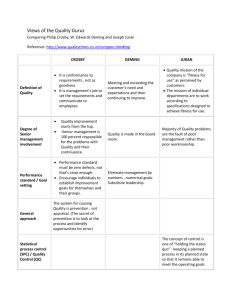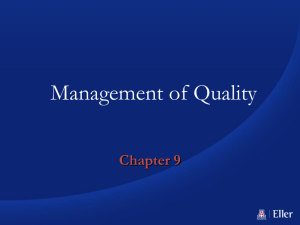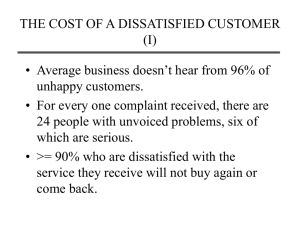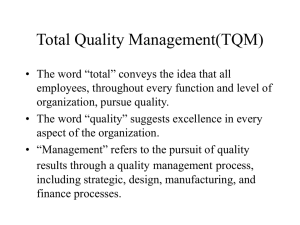MIT SCALE RESEARCH REPORT
advertisement
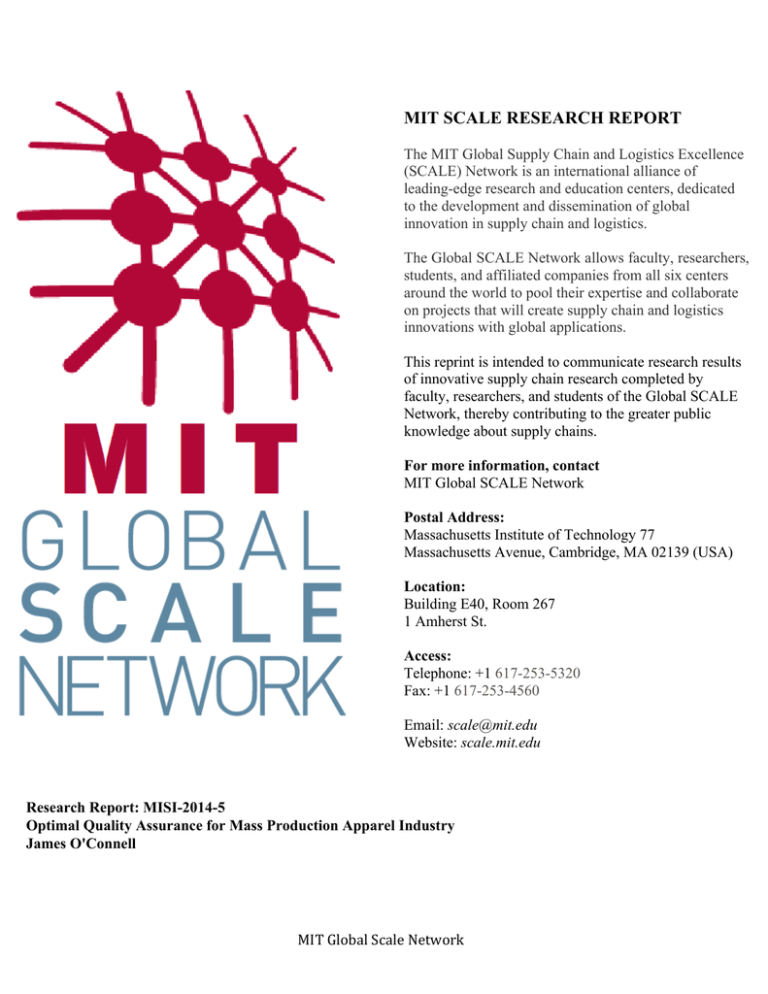
MIT SCALE RESEARCH REPORT The MIT Global Supply Chain and Logistics Excellence (SCALE) Network is an international alliance of leading-edge research and education centers, dedicated to the development and dissemination of global innovation in supply chain and logistics. The Global SCALE Network allows faculty, researchers, students, and affiliated companies from all six centers around the world to pool their expertise and collaborate on projects that will create supply chain and logistics innovations with global applications. This reprint is intended to communicate research results of innovative supply chain research completed by faculty, researchers, and students of the Global SCALE Network, thereby contributing to the greater public knowledge about supply chains. For more information, contact MIT Global SCALE Network Postal Address: Massachusetts Institute of Technology 77 Massachusetts Avenue, Cambridge, MA 02139 (USA) Location: Building E40, Room 267 1 Amherst St. Access: Telephone: +1 617-253-5320 Fax: +1 617-253-4560 Email: scale@mit.edu Website: scale.mit.edu Research Report: MISI-2014-5 Optimal Quality Assurance for Mass Production Apparel Industry James O'Connell MITGlobalScaleNetwork For full thesis version please contact: Professor Shardul Phadnis Director of Research MISI No. 2A, Persiaran Tebar Layar, Seksyen U8, Bukit Jelutong, Shah Alam, 40150 Selangor, Malaysia. Phone: +6 03 7841 4845 Email: sphadnis@misi.edu.my MITGlobalScaleNetwork Optimal Quality Assurance for Mass Production Apparel Industry By: James O'Connell Thesis Advisor: Dr. Albert Tan Summary: The quality assurance process for an apparel company was examined. After determining how the company was performing on quality and the location and potential causes of the quality issues, a value stream analysis was performed to determine the best allocation of the quality assurance resources. The determination was that too many resources were being used at the packaging inspection, while many of the issues were not being caught by the incoming quality inspection. An analysis of the current employee incentive system for producing quality products and a suggested alternative were also discussed. James holds a Bachelor of Arts degree in Political Science as well as a Juris Doctorate from Columbia University. Prior to joining the Malaysia Institute for Supply Chain Innovation, he worked for a healthcare incubator, working on a range of startups in the healthcare sector, as well as clerked for the Santa Clara District Attorney. KEY INSIGHTS 1. Breaking down the quality issues into various categories and stages for analysis can help determine the causes of the quality issues and possible areas to focus on to improve quality. 2. Value stream mapping can be applied specifically to the quality assurance process to get a better understanding of where the waste in the quality process exists. 3. Improving the quality of production can require more than just changing the inspection process, increasing the willingness of employees to put their own focus on the quality of their work can help eliminate issues before they appear. © 2014 James O'Connell Page 1 of 6 Introduction The apparel industry covers a wide range of product types from high fashion products with short life cycles to everyday use clothes with long life cycles. Each area has its own production techniques and supply chain requirements. Regardless of the type of apparel product, ensuring quality is a key issue for all apparel companies. Failure to maintain quality levels can have an adverse impact on a company. First, it can subject them to governmental sanctions if they fail to meet governmentally mandated quality metrics. Second, failure to provide a good quality product to the consumers causes multiple problems. It leads to customer returns, which means less revenue and a more complicated supply chain. It also leads to a loss of customer sales, as customers stop trusting that they will receive a quality product if they buy it. Determining a way to improve the quality assurance process could lead to both significant cost savings and a more satisfied customer base. Research was done with a large apparel manufacturer to try to answer two questions for the manufacturer: How effective is the current process at meeting the quality goals of the company and is the allocation of quality assurance resources the best that the company can do? The Current Situation The research focused on a single facility of the company containing two factories. The quality assurance process was as follows. © 2014 James O'Connell Figure 1: Flow of Activity for Factory Material is delivered to the facility from both internal sources (the Nanjing facility) and external suppliers. A portion of the incoming goods are then examined at the incoming quality inspection (ICQ). It is then stored in a warehouse until needed for production. After the product is sewed, a portion are investigated at the end of line inspection point (EOL) and if they pass, are moved onto packaging. After packaging, the products are inspected again and then put in cases. A final inspection (FML) takes place before the products are sent to a distribution center. Overall, the facility did a good job in adhering to the inspection guidelines. There were only a few instances of deviation from the required number of inspections. However, the quality of the products produced in terms of defects was not meeting the company's goals. Page 2 of 6 Weekly Defect Rate for EOL 1 2 3 4 5 6 7 8 9 Overall 5.00% 4.00% 3.00% 2.00% 1.00% 0.00% Factory 1 Factory 2 Figure 2: Weekly Defect Rate for EOL Neither factory managed to produce below the maximum allowable defect rate in the nine weeks of study. There appear to be several issues contributing to the failure to meet the quality goals of the company. The first is in the quality of the materials reaching the production line. Percent of Defects Defect Location Breakdown 100.00% 90.00% 80.00% 70.00% 60.00% 50.00% 40.00% 30.00% 20.00% 10.00% 0.00% from the company's own facility in Nanjing was not as good. Almost 30% of the defects detected at the EOL inspection in Factory 2 were due to quality issues outside the control of the production facility. Examining the quality issues under the control over the facility revealed that while some of the defects were associated with specific product styles, others appeared to be due to issues with the production lines themselves. Style B749A5 Issue Stitch Runoff Defective Cutting Defective Cutting Location Issue 2252P8 MCB3A5 Magnitude 11.4 Times Expected 9.4 Times Expected 7.6 Times Expected Magnitude 9.7 Times Bali 96-99 Incorrect SPI Expected Body Trim 7.3 Times Ritmo 135-138 Shading Expected Logo Off 6.7 Times Ritmo 91-94 Center Expected Table 1: Style Type and Location Quality Issues Third Party Extern al Comp any Extern al Intern al Factory 1 0.50% 8.89% 90.60% Factory 2 1.42% 28.51% 70.07% After determining how the facility was performing in terms of quality, the next step was to determine if the quality assurance resources were being allocated properly. This was done by a value stream analysis of the quality assurance process in the facility. Figure 3: Defect Location Breakdown While issues with the quality of products from third party suppliers was fairly low (below 1.5% for each Factory), the quality © 2014 James O'Connell Page 3 of 6 EOL due to issues with the incoming materials, reassigning some of these auditors to the ICQ could help mitigate the quality issues facing the company. Figure 4: Value Stream Map Inspections v. Defects 120.0 100.0 80.0 1918.2 60.0 728.0 46.3 40.0 20.0 5.8 0.0 4068.3 110.0 457.9 7.3 Defects 5000.0 4000.0 3000.0 2000.0 1000.0 0.0 Per Person Inspections Per Person Defects Figure 5: Value Stream Analysis: Inspections v. Defects Examined at a per employee per week inspection level, the EOL and FML were by far the most productive in terms of both inspections and defects detected. While the ICQ was performing the fewest inspections per week, the area with the most waste was at Packaging inspection. The inspectors were examining almost twice as many products as the ICQ and were finding significantly fewer defects. For the allocation of resources to be consistent with this, the defect rate at the packaging station would have to more than double. This was partially due to the allocation of eight special auditors to help with the packaging inspections, leading the packaging station to have by far the most personnel involved. With many of the quality issues found at the © 2014 James O'Connell Recommendation Determining the reasons behind why the company was not meeting their goals and where improvements can be made provided some of the following recommendations. Overall, nearly 30% of the defects discovered at the EOL stage in Factory 2 were due to problems originating from material produced at the Nanjing facility, as opposed to under 10% for Factory 1. While some of these should have been caught by the incoming material inspection process, reducing the defective products that come in from the Nanjing facility would greatly help lower the defect rates. Increasing the inspection at the ICQ or improving the quality process in Nanjing would help eliminate these defects from reaching any further down the chain. Looking at the breakdown of the defects, there was a mix of defects related to the product itself and defects relating to the lines producing the product. In both the incoming material products and the finished good products, there were several product types in each that had high defect rates. When comparing specific defects with both product lines and production lines, it was clear that most of the problems were due to the products themselves, but there were notable exceptions, where it was individual lines that caused the issues. A closer examination of product designs and the specific problems lines are having should be performed to determine the root causes of the problems and find ways to bring them in line with the rest. The value stream mapping provided some insight into the quality assurance resource allocation. It identified the area Page 4 of 6 where the company was getting the least utilization of their personnel (in terms of defects detected per inspection). That was the packaging inspection, where the number of packaging auditors is much higher than is warranted based on the number of defects currently being produced. While this is based on all defects being treated equally, and packaging defects could have an outsized influence on the end-consumer willingness to buy, this is a good place to start looking for a better allocation of personnel. In short, the packaging auditors are not adding enough value and should be moved to another area in the process, possibly the ICQ. The visit to the facility also led to an observation on how the employees are currently being motivated and the effect it may be having on the quality process. The effect can be seen in the Figure 14. quality, there is extra work/more rework that needs to be done. This rework both increases the costs of the facility as well as increasing the quantity of products that need to be made (to have sufficient good quality products to meet the demand). The net effect of this is that while the salary and cost loops balance themselves, the quality/rework/amount required loop is reinforcing, meaning as the quality drops, more rework is needed, causing more products to be required and made, further decreasing the quality. It also has the impact of increasing the costs and decreasing the margins for the balancing loops. There are two points to combat this problem. They are at the # Produced to Quality stage and the Quality to Extra Work/Rework stage. Dealing with it at the first stage is preventive, it stops the extra work from having to be performed, while dealing with the second is reactive, trying to limit the impact it is having on production. From a total quality management approach, dealing with the problem before it actually emerges and embedding quality in the process is the preferred method. This suggests Figure 15. Figure 6: Current Employee Incentive Flow Currently, the employees performing the sewing are being paid a base amount as well as an extra amount per piece they produce. This has multiple effects. As for right now, as each employee produces more pieces, they get paid a higher salary. This increases the costs for the facility, which decreases the margin. It also has an impact on quality. As an employee is paid more for producing more, they have an incentive to produce faster. This reduces the quality of the products being produced and with lower © 2014 James O'Connell Figure 7: Suggested Employee Incentive Flow Instead of basing the financial incentive just on the quantity produced, also base it on the quality of work being done. This could be something like percent of work that passes inspection. What this does is adds in another Page 5 of 6 reinforcing loop to the system. Salary would no longer just be affected by the quantity being produced, but by the quality of that work as well. This would provide the employee with an incentive to not only produce quickly, but to produce a quality product as well. This should improve the quality of the products in the process and decrease the amount of rework being done, which both decreases the cost to the system from that rework as well as the amount of products required to be made to meet the customer demand. Essentially the new reinforcing loop helps to mitigate the effects of the other reinforcing loop by taking place earlier in the process and letting less reach the point of extra work/rework. This approach would increase the pride in workmanship and give everyone an incentive to ensure that a quality product is being made. While determining how to actually implement something like this may be difficult, it is offered as something to ponder when working on how the process is being performed. Conclusion While the company was doing a good job at following the guidelines set for determining quality, it was not meeting its quality production goals. This was due to issues with the quality of some of the incoming products, issues with specific styles, issues with specific production lines and more. The quality assurance resources were being overspent in packaging inspection and could be re-assigned to help inspect the quality of the incoming goods. The company could also look to how they compensate employees as a method to help improve the quality of the production. © 2014 James O'Connell Page 6 of 6
